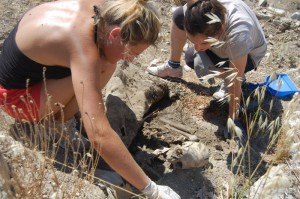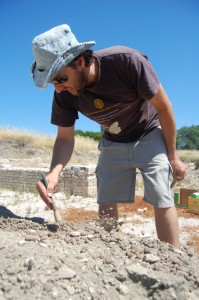Archaeologists uncover the life—and deaths—along the Via Flaminia

With the June sun beating down on their backs, University of Urbino student archaeologists Laura Invernizzi (left) and Lara Pollidori (right) come face to face with one of 44 ancient Roman skeletons unearthed at the Archaeological Park of Forum Sempronii. (photo by Megan Northcote)
A soft whirring of propeller blades breaks the silence of the sunny, late May afternoon in the Italian Marche countryside. Archaeologist Oscar Mei, hovering in a helicopter, peers down to observe the Archaeological Park of Forum Sempronii, the site of a partially excavated ancient Roman colony. At first glance, the land appears a vast 60- to 70-acre sea of green wheat. Only the Strada Statale 3, a modern day highway, is clearly visible, bisecting the town along the same route the Via Flaminia followed more than 2,000 years ago from Rome to Rimini on its way to the Adriatic Sea.
Mei holds out his camera, snaps a photo of the town’s southeastern quadrant, and reviews the image. The camera screen appears entirely green. But then he zooms in. In the midst of the green field emerges a clearly defined, yellow ochre semi-circle. Instantly, he has a hunch about what lurks beneath the wheat at this unexcavated section of town—a Roman amphitheatre. Turns out, he was right.
Mei joined the ranks of students working at Forum Sempronii in 1994, adding to 20 years of ancient Roman ruin discoveries made by archaeologists-in-training. Every summer since 1974, Mario Luni, director of excavations at the site and classical archaeology professor at the University of Urbino, has instructed students like Mei in 40-day field schools. Forum Sempronii is located 15 miles southeast of Urbino, within the present day town of Fossombrone.
Under Luni’s meticulous guidance, Mei worked (or dug) his way up the excavation ladder, also becoming a professor of archaeology and now serving as Luni’s assistant director of excavations. “Mario Luni gave me the opportunity to work to the highest level of archaeology,” Mei said. “He taught me you have to work with an open mind and without preconceptions.”
For instance, Mei’s assumption that the semi-circular pattern in the photo represented a Roman amphitheatre wasn’t enough to please Luni. They had to dig before deciding if Mei’s hypothesis held true. It did. Last year, Luni and Mei assisted students in excavating the entrance of the amphitheatre, uncovering cobblestone walls approximately a yard high as well as part of the original floor.

Archaeologist Oscar Mei brushes off dirt and pebbles covering a Roman skeleton found near the Via Flaminia. (photo by Megan Northcote)
How do Mei’s aerial photos enable archaeologists to see beneath the soil and detect where Roman ruins are hidden? It’s not magic. As Mei explains, every year between late May and early June when the wheat is in full bloom, archaeologists have about 10 days (before the entire field turns brown) to detect the yellow ochre lines caused by the ancient structures hidden beneath the soil. These structures prevent ample nutrients from reaching the plants directly above, killing that wheat a few days earlier than the rest of the field.
But you don’t always need a camera to uncover the past. Sometimes a bit of luck and modern day construction will do the trick. The entire ancient town was discovered in 1974 when construction workers, planning to lay the foundation for a new industrial city, accidentally dug into the settlement’s crumbling walls.
Forum Sempronii was founded by Gaius Sempronius Gracchus in 133 BC. For over 700 years, between 200 BC and 500 AD, this small town teemed with life, boasting between 3,000 and 5,000 inhabitants, primarily farmers. Other residents, Luni said, worked as soldiers, magistrates, and merchants, who traveled up and down the Via Flaminia trying to eke out a living.
Constructed between 223 and 220 BC under Roman Consul Caius Flaminius, the Via Flaminia both increased trade among roadside towns and served as a military thoroughfare down which Roman soldiers marched into battle. As the first main Roman road running through Italy, the Via Flaminia greatly expanded the empire.
“Just as Americans settled their country from east to west, the Romans moved from west to east, toward the Adriatic Sea. Before the Romans, the land along the Via Flaminia was wild, without agriculture. The Romans reclaimed the fields,” Luni explained. Gracchus founded Forum Sempronii in the Metauro River Valley after the passage of lex Sempronia, an agricultural law, which mandated equitable distribution of land to farmers.
Thanks to Mei, every finding excavated at Forum Sempronii by the university, from the smallest pottery shard to the longest ancient wall, has been meticulously described, measured, photographed and documented in his excavation diary. Among these are several large structures, all within two-and-a-half acres, including: small, private thermal baths; larger, public baths; a 200-meter-long cobblestone stretch of the Via Flaminia intersected by parts of smaller side roads; and a domus or Roman house.
[pullquote]The first structure the Romans constructed was not the forum, basilica, or temple, but the baths.[/pullquote]
Working with their students, Luni and Mei have gleaned much information about daily Roman life through careful examination of these findings. The presence of not just one, but two Roman baths in such a small town suggests the importance these baths held as a means of bringing the community together, especially since the baths were often free or cost very little. “Roman baths are a symbol of Roman life,” Mei said. “For example, in many colonies in the Mediterranean, in Africa, in eastern Turkey, and in Roman colonies, the first structure the Romans constructed was not the forum, basilica, or the temple, but the baths. If I go into the baths, I am a Roman citizen. That was the mentality of this period.”
Yet some sections of Forum Sempronii were more socially stratified. Two mosaics, for example, were found on the dining room and bedroom floor when excavating the domus close to the Via Flaminia, suggesting that most people who lived inside the city were wealthier than those who lived further outside. “Romans decorated their homes with mosaics of exotic animals like giraffes and tigers to show off their wealth and to welcome guests to their home,” Luni said.
Even smaller objects found in the ditches used for dumping trash outside the domus reveal much about the Romans’ daily activities and diet. Among the lucky finds: gold jewelry, Roman coins, rusty keys, a game die, mussel and clam shells, chicken bones, and even the residue of a kind of Roman cocktail sauce called garum lining the walls of a ceramic pot. To make garum, Mei said, the Romans would pour a mixture of oil, lemon, and vinegar over fish intestines placed inside a bowl and allow it to sit for three months. It was used for flavoring fish and meats.
But it’s not just material culture that’s being excavated and documented; ancient Romans are, too. About 15 years ago, with the help of aerial photography (of course!), Mei and Luni’s team stumbled upon a skeleton buried along the Decamanus minor, a side road intersecting the Via Flaminia in the center of town. Over the years, one by one, more and more skeletons were discovered, all buried inside the walls of Roman shops along this side road. In recent years, the archaeological team has mapped a total of 44 skeletons, all of which, laboratory tests reveal, fell victim to the Black Death, a plague that killed many people in Italy around the 5th century AD, roughly corresponding the abandonment of Forum Sempronii.
During the most recent archaeological work, in the summer of 2012, students re-excavated some of these same bodies, removing bones for further laboratory analysis to determine their gender and age. Nearby, another group continued to unearth more interior sections of the domus and the baths. In addition, students pursued further excavations of the amphitheatre that Mei originally spotted from his perch in the helicopter. Equipped with small trowels called scopettas, cameras, and sketch pads, these archaeologists-in-training will continue to explore Roman ruins that lie beneath those short-lived, yellow ochre patterns in the field.
Archaeological Park of Forum Sempronii
Via San Martino del Piano
Fossombrone, Italy
Open in July, 8 a.m.-5 p.m. by appointment (e-mail oscar.mei@uniurb.it)
During off-hours, site is viewable from behind fencesArchaeological Museum “A. Vernarecci”
Palazzo Ducale Corte Alta, Via del Verziere
Fossombrone, Italy
072 171 4645
bit.ly/archeo-museum
Summer: 10:30 a.m.-12:30 p.m., 4 p.m.-7 p.m. (closed Monday)
Winter: Saturday 3:30-6:30 p.m., Sunday 10 a.m.-12 p.m. and 3:30-6:30 p.m.
This article is from Urbino Now magazine’s Arte e Cultura section, which reports on the arts and culture of Urbino and the Le Marche region. Please view more magazine articles or order a complete printed copy of Urbino Now.